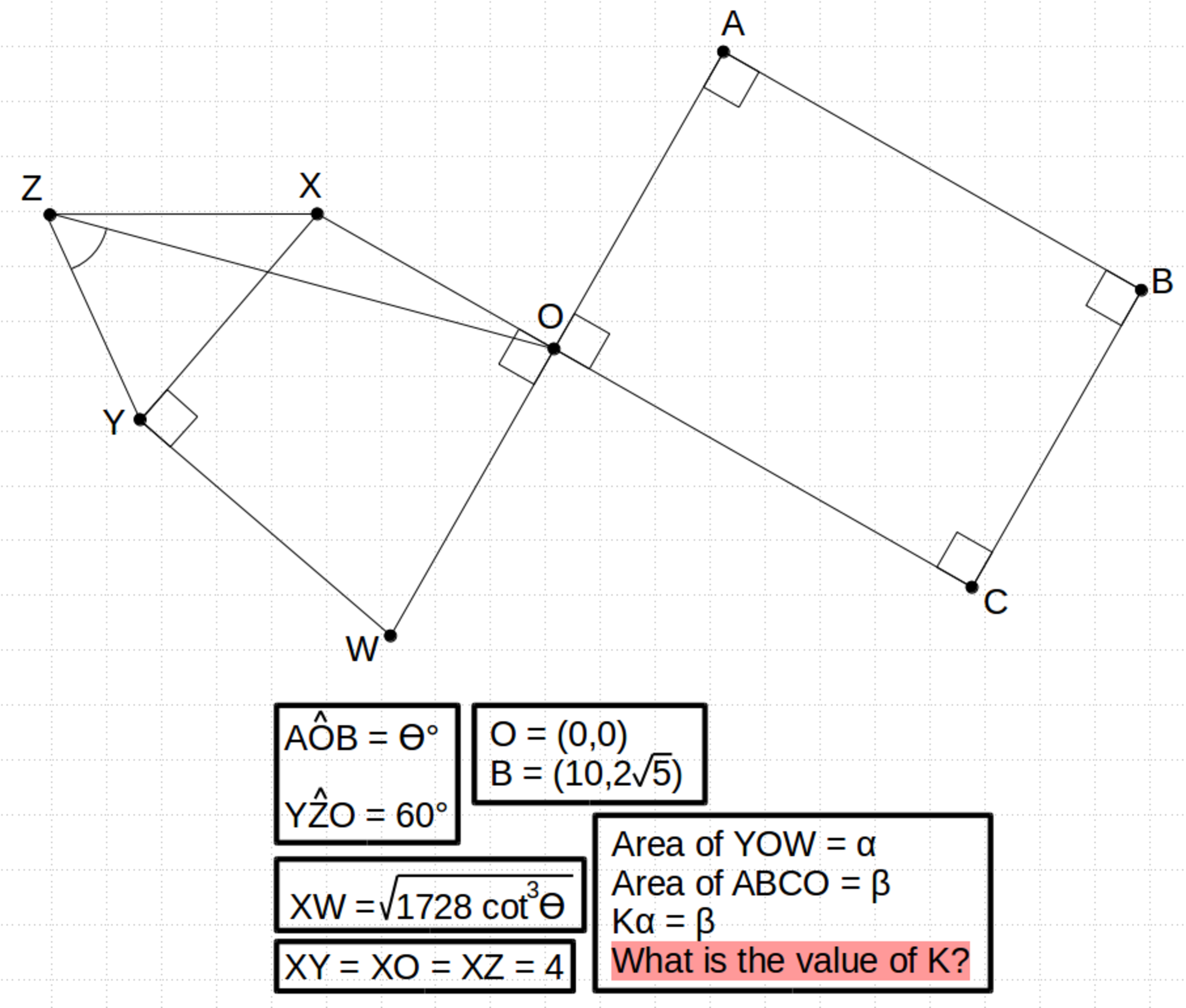The 'Ivan' Question
Geometry
Level
pending
Using the diagram given and the relevant information below, answer the question:
What is the value of K if Kα = β

2 x Root(5)
Root(3)
2
Root(5)
This section requires Javascript.
You are seeing this because something didn't load right. We suggest you, (a) try
refreshing the page, (b) enabling javascript if it is disabled on your browser and,
finally, (c)
loading the
non-javascript version of this page
. We're sorry about the hassle.
Firstly,
1) Focus on points Z, X, Y and O and angle YZO, which is 60 degrees as told.
2) The lengths of XY, XO and XZ are all 4 (as told), which allows you to draw a circle of radius 4 with centre point X, while Z, Y and O all sit on the circumference of the circle.
3) By taking advantage of one of the circle theorems that any angle on the circumference of a circle subtended from two points on the circumference is always half of the angle coming from the centre of the circle subtended from the said two points . Thus, the angle YZO (which is 60 degrees) is half of the angle YXO. Making angle YXO = 120 degrees.
Secondly,
1) Focus on the quadrilateral XOWY with YXO = 120 degrees.
2) By observation, you can see that XOWY is made up of two right angle triangles. Thus, by drawing lines XW and YO, you split the quadrilateral into 4 new right angle triangles.
3) Let the point of intersection of lines XW and YO be M. By observation, Angles MXY and MXO are equal and angle YXO = 120 degrees, so angles MXY = MXO = 60 degrees. So angles MYX = MOX = 30 degrees. Angles MYW = MOW = 60 degrees and angles MWY = MWO = 30 degrees.
4) Using trigonometric ratios for right angles that contain angles 30 and 60 degrees and the fact that XO = XY = 4, you can quickly deduce that length XM = 2 and length MW = 6, so now we know XW = 8 = Root(1728 x cot^3(ϴ))
Thirdly,
1) Focus on your new equation {8 = Root(1728 x cot^3(ϴ))}.
2) Using simple algebraic techniques and rearrangement, you can derive that 1/27 = cot^3(ϴ). So 1/3 = cot(ϴ).
3) Using trigonometric identities and an algebraic technique, you can derive that:
cos(ϴ)/sin(ϴ) = x/3x
cos(ϴ) = x and sin(ϴ) = 3x
x^2 + 9x^2 = 1 (using the identity sin^2(ϴ) + cos^2(ϴ) = 1)
10x^2 = 1
x = 1/Root(10) (positive root since we will be using x to derive the lengths for rectangle ABCO)
4) cos(ϴ) = 1/Root(10) and sin(ϴ) = 3/Root(10)
Fourthly,
1) Focus on the coordinates of points O = (0,0) and B = (10,2 x Root(5)).
2) By finding the magnitude of length OB using good old Pythagoras theorem, you can derive that length OB = 2 x Root(30)
3) You can observe that length OB splits rectangle ABCO into two congruent right angle triangles. Take triangle AOB and observe using the information given that angle AOB = ϴ degrees. Using basic trigonometric knowledge and the fact that the hypotenuse of triangle AOB is of length 2 x Root(30), you can derive that:
OA = cos(ϴ) x 2 x Root(30) = 1/Root(10) x 2 x Root(30) = 2 x Root(3)
AB = sin(ϴ) x 2 x Root(30) = 3/Root(10) x 2 x Root(30) = 6 x Root(3)
4) Thus, you can now see that the lengths of the sides of rectangle ABCO are 2 x Root(3) and 6 x Root(3), and by calculating the area of this rectangle using the known information, we find that area ABCO = 36 = β
Lastly,
1) Focus on triangle YOW and any measurements you have left behind when finding length XW.
2) Using the lengths and angles you have left behind, you can quickly find the area of triangle YOW using the simple triangle area formulas you should already know, and you find that the area of triangle YOW = 12 x Root(3) = α
The Cherry on the Top,
1) Focus on the given information: Kα = β
2) Use your know values for αlpha and βeta to get:
K x 12 x Root(3) = 36
K x Root(3) = 3
K = 3/Root(3)
3) K = Root(3)
I made this question during a boring school assembly. Hope you had fun.